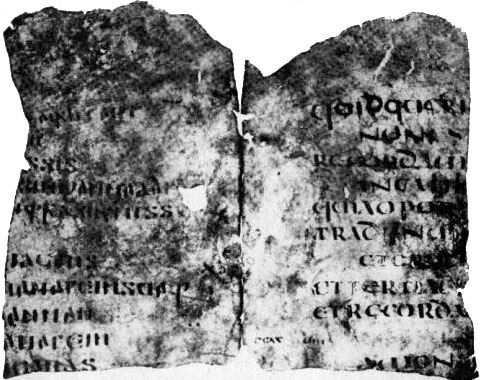Codex Gissensis on:
[Wikipedia]
[Google]
[Amazon]
 The Codex Gissensis ( Universitätsbibliothek Giessen, Handschrift 651/20) was a fragmentary
The Codex Gissensis ( Universitätsbibliothek Giessen, Handschrift 651/20) was a fragmentary
"The Gothic Text of Codex Gissensis."
In Christian T. Petersen (ed.), ''Gotica Minora II: Scripta nova et vetera''. Frankfurt, 2003): 1-20. 6th-century biblical manuscripts Gissensis Gothic Bible Lost biblical manuscripts 1945 disestablishments in Germany
 The Codex Gissensis ( Universitätsbibliothek Giessen, Handschrift 651/20) was a fragmentary
The Codex Gissensis ( Universitätsbibliothek Giessen, Handschrift 651/20) was a fragmentary parchment
Parchment is a writing material made from specially prepared Tanning (leather), untanned skins of animals—primarily sheep, calves and goats. It has been used as a writing medium in West Asia and Europe for more than two millennia. By AD 400 ...
manuscript
A manuscript (abbreviated MS for singular and MSS for plural) was, traditionally, any document written by hand or typewritten, as opposed to mechanically printed or reproduced in some indirect or automated way. More recently, the term has ...
, a Gothic–Latin
Latin ( or ) is a classical language belonging to the Italic languages, Italic branch of the Indo-European languages. Latin was originally spoken by the Latins (Italic tribe), Latins in Latium (now known as Lazio), the lower Tiber area aroun ...
diglot containing texts of the Bible
The Bible is a collection of religious texts that are central to Christianity and Judaism, and esteemed in other Abrahamic religions such as Islam. The Bible is an anthology (a compilation of texts of a variety of forms) originally writt ...
in Gothic on the left and Latin on the right.D. Gary Miller, ''The Oxford Gothic Grammar'' (Oxford University Press, 2019), p. 11.
The manuscript was made in the 6th century AD. Brian Murdoch, "Gothic", in Brian Murdoch and Malcolm Read (eds.), '' Early Germanic Literature and Culture'' (Boydell & Brewer, 2004), p. 158. Only a double-folio single leaf was known. It was discovered in Antinoë in Egypt
Egypt ( , ), officially the Arab Republic of Egypt, is a country spanning the Northeast Africa, northeast corner of Africa and Western Asia, southwest corner of Asia via the Sinai Peninsula. It is bordered by the Mediterranean Sea to northe ...
and in 1907 brought to the German town Giessen
Giessen, spelled in German (), is a town in the Germany, German States of Germany, state () of Hesse, capital of both the Giessen (district), district of Giessen and the Giessen (region), administrative region of Giessen. The population is appro ...
, from which it gets is common name. During World War II
World War II or the Second World War (1 September 1939 – 2 September 1945) was a World war, global conflict between two coalitions: the Allies of World War II, Allies and the Axis powers. World War II by country, Nearly all of the wo ...
, the manuscript was placed in the vault of the Dresdner Bank
Dresdner Bank AG () was a German bank, founded in 1872 in Dresden, then headquartered in Berlin from 1884 to 1945 and in Frankfurt from 1963 onwards after a postwar hiatus. Long Germany's second-largest bank behind Deutsche Bank, it was eventually ...
branch in Giessen to protect it from air raids. In 1945, the river Lahn
The Lahn () is a , right (or eastern) tributary of the Rhine in Germany. Its course passes through the States of Germany, federal states of North Rhine-Westphalia (23.0 km), Hesse (165.6 km), and Rhineland-Palatinate (57.0 km).
...
flooded the vault and the manuscript was destroyed. The manuscript can be studied today only from photographs taken in 1910.E. A. Ebbinghaus, "Some Observations on Codex Gissensis", ''General Linguistics'' 29.4 (1989): 276.
The Gothic column contain the text from '' Luke'' 23:11–14 and 24:13–17, while the Latin contains some from ''Luke'' 23:3–6, 24:5–9. The Gothic Bible
The Gothic Bible or Wulfila Bible is the Christian Bible in the Gothic language, which was spoken by the Eastern Germanic (Goths, Gothic) tribes in the Early Middle Ages.
The translation was allegedly made by the Arianism, Arian bishop and m ...
is the 4th-century translation of Ulfilas, while the Latin is the ''Vetus Latina
The ''Vetus Latina'' ("Old Latin" in Latin), also known as ''Vetus Itala'' ("Old Italian"), ''Itala'' ("Italian") and Old Italic, and denoted by the siglum \mathfrak, are the Latin Bible translations, translations of biblical texts (both Old T ...
'' with some readings from the Vulgate
The Vulgate () is a late-4th-century Bible translations into Latin, Latin translation of the Bible. It is largely the work of Saint Jerome who, in 382, had been commissioned by Pope Damasus I to revise the Gospels used by the Diocese of ...
.
References
{{reflistFurther reading
*Snædal, Magnús"The Gothic Text of Codex Gissensis."
In Christian T. Petersen (ed.), ''Gotica Minora II: Scripta nova et vetera''. Frankfurt, 2003): 1-20. 6th-century biblical manuscripts Gissensis Gothic Bible Lost biblical manuscripts 1945 disestablishments in Germany